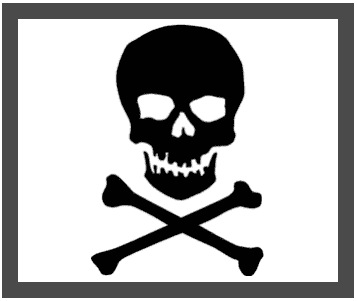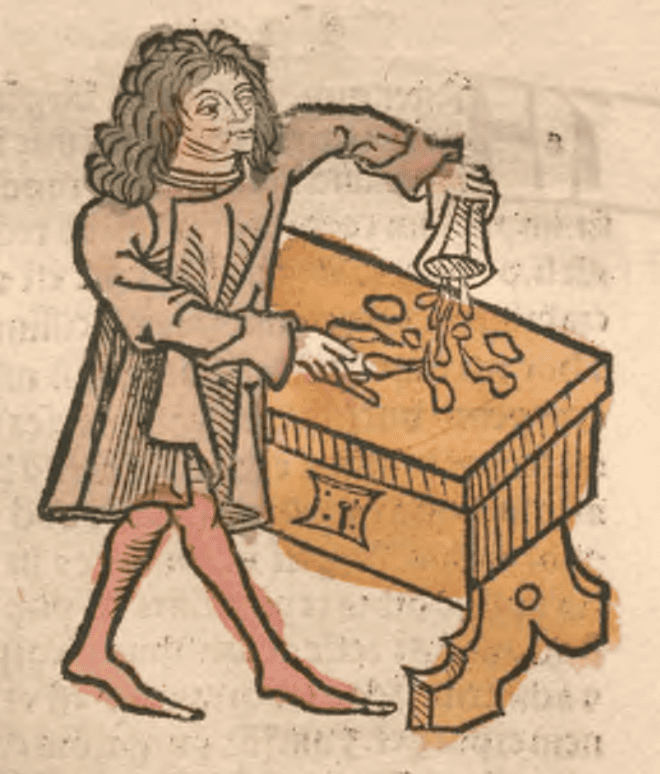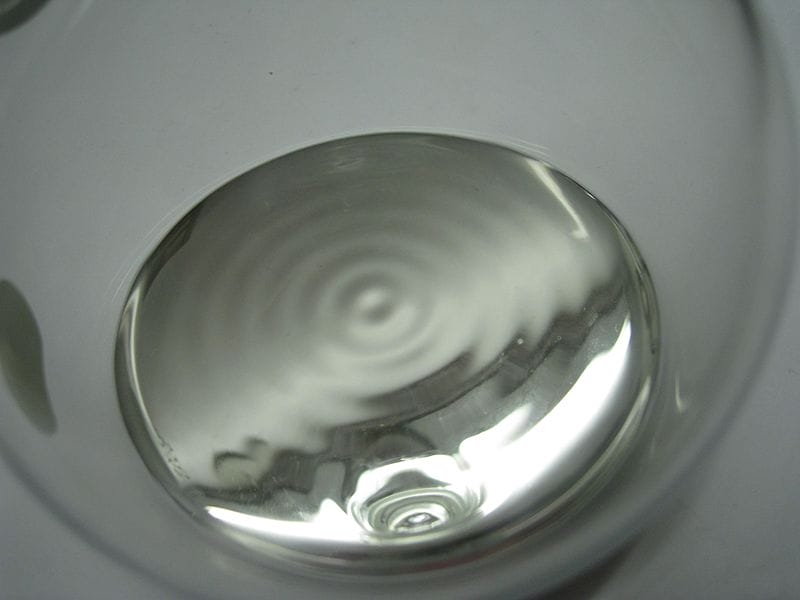Argentum Vivum, Mercury, Shui Yin 水银Hydrargyrum: Quicksilver: older names include: Alohar: Altaris: Alozet: Azoch: Azet: Besech: Besec; Argentum VivumRasa, Para, Parada (Ayurveda) Shui Yin (TCM) Prepared Mercury: –Tsothel, Btso thal (Tibetan Medicine) –Zuotai (TCM) |

|

|

 Hortus sanitatis, 1491
Hortus sanitatis, 1491 Mercury
MercuryPhoto by Dnn87
Minerological name:
Hydrargyrum
Parts used:
Purified Mercury.
Most commonly used internally in all Traditions is a Sulphide form:
1. Red Sulphide:
a. Cinnabar–natural red sulphide of Mercury
b. Vermillion–artificial red sulphide of Mercury
2. Black Sulphide (Kajjali), prepared by triturating purified Mercruy (1 part) with Sulphur (1–6 parts)
In addition, Ayurveda and Tibetan have special processes to purify and potentise Mercury. This is an elaborate 8 stage process. The end result is a prepared Mercury sulphide and while this generally has the same uses as Mercury sulphides, it is regarded as infinitely superior, and stronger to rejuvenate the body.
Sulphides:
1. Cinnabar: Cinnabaris (see separate monograph): Sinople: Vermillion: Cynnabar: Bergzinober: Blood of the Dragon: Ore or Earth of Quicksilver (German): Zhu Sha (TCM): Hingula (Cinnabar, Ayurveda); Rasa Sindura (Vermillion, Ayurveda).
Note: the name ‘Cinnabar’ is generally reserved for the native product; Vermillion is usually used for the artificial; Mercuric Sulphide
2. Ethiopian Mineral: called Kajjali in Ayurveda: prepared by thoroughly mixing Mercury with Sulphur to form a black mass (Black Mercury Sulphide); if sublimed it forms Vermillion (Red Mercury Sulphide).
Precipitates (Oxides):
1. Calx Murcurii: Precipitated Mercury: Mercurius Calcinatus: Mercuric Oxide: HgO
2, Yellow Precipitate: Yellow Oxide of Mercury. HgO
3. Red Precipitate: Mercurius Precipitate: Red Oxide of Mercury. HgO
4. French White Precipitate: French formulas referred to Calomel as ‘White Precipitate’.
5. Corrected Precipitate: Red Precipitate which has been well washed to remove its emetic quality.
Other Mercury Salts:
1. Calomel (see separate monograph): Hydrargyri Chloridum: Calomelanos: Mercurius Dulcis: Manna metallorum: Aqila alba: Panchymagogum minerale: Draco mitigatus: Mercurius Dulcis: Subchloride of Mercury: Mercurous Chloride: HgCl
2. White Precipitate: Mercuric Chloride Ammoniated: Ammoniated Mercury. NH2HgCl
More irritating than the Oxides, only used externally; there are also other ‘White Precipitates’–French White Precipitate is Calomel
3. Corrosive Sublimate: Bichloride of Mercury: Perchloride of Mercury: Corrosive Chloride of Mercury: Sublimed Mercury: Mercuric Chloride. HgCl2.
4. Turpeth Mineral: a hydrolysed form of Mercuric Sulphate. Salt of Alembroth: a double chloride of mercury and ammonium, Hg2(NH4)2Cl4.H2O
See also Cinnabar, Calomel and Prepared Mercury (Btso thal) of Tibetan Medicine.
Temperature & Taste:
Cool, moist. Tasteless. Toxic
“Quick Silver is Cold and Moist in the Second degree.” (Avicenna)
However, others stated that it had complex properties, both hot and cold, dry and moist.
“The chemists consider it both Cold and Moist in the 4th degree, liquid in the 3rd, white in the Second and dark in the First. There are, moreover, other opinions” (Lexicon of Alchemy)
Properties:
Hardness: liquid at room temperatures.
Specific gravity (normal temperature): 13.6. Mercury becomes volatile and evaporates at 357.25 degrees centigrade.
Crystallises in the trigonal system (at -39 degrees), in the Rhombohedron crystal form.
Not soluble in most solvents including Hydrochloric acid and cold Sulphuric acid, but dissolves in hot Sulphuric acid, and also readily dissolves in Nitric Acid.
It forms an amalgam with most metals except Iron, Nickel, or Platinum. Therefore it should not be stored in vessel of Copper, Silver, Bronze etc., but rather in Iron or Enamel containers, or small amounts may be kept in glass.
It should be triturated only in mortars of Stone, Marble, Glass, Iron or Enamel.
Constituents of Processed Mercury of Ayurveda and Tibetan Medicine:
Inorganic mixture of HgS (metacinnabar, cubic mercuric sulfide (β-HgS) and minor hexagonal mercuric sulfide (α-HgS), sulphur, graphite, and traces of other organic elements (Fe, Cu, Al) in nanoparticle form (100–800 nm range)
Uses:
1. Clears Heat, Resists Poison:
-cleanses Heat and Poison from the Blood
-Epidemic diseases, Fevers inc. chronic and obstinate Fever
-Syphilis, Gonorrhea
-regarded as effective for a range of poisons (Ayurveda, Tibetan Medicine)
-“resists all manner of Putrefaction and Malignity in the whole Body proceeding either from bitings of venomous Creatures, Poison, Pox, Plague, &c.”. (Salmon)
-“purifies even the Marrow in the Bones”. (Salmon)
2. Nourishes Yin, Increases Essence:
-Tonic, nourishing the Tissues and Essence
-improves Intelligence, promotes awareness and increases Memory
-halts progress of old age, promotes Longevity
–this indication is only in the processed Mercury of Tibetan and Ayurvedic medicine.
3. Regulates Qi, Opens Obstructions, Eases Pain:
-Paralysis, Hemiplegia
-Myalgia, Arthritis, Rheumatoid Arthritis
-Edema, Gravel
-Neuralgia, Migraine
4. Moves the Blood, Resolves Masses:
-nodes, scrofula, lymphadenitis, glandular swellings
-Fibroid Tumors, Cancer
-“dissolves all manner of coagulations and congealations of Blood and Humours”. (Salmon)
5. Kills Worms:
-Worms; Parasites
6. Externally:
-chronic skin diseases, Lymphatic inflammations, glandular swellings
-parasites, fungal infections
Dose:
Dosing is very important in the successful use of Mercury. In chronic and obstinate diseases, three types of dosing are typically used:
1. Mercury is taken in compounds once or twice weekly, sometimes once or twice monthly, on a moderate-to-long-term basis (ie. Tibetan Jewel Pills)
2. Mercury is used daily for no more than 2 weeks, followed by a period of several weeks intermission before resuming.
3. Mercury is begun in very small dose, increased gradually, maintained for a specified period, then the dose is gradually reduced
Diet is also very important. Most importantly Salt should be totally avoided while using Mercury. Milk, Ghee and Rice are good to have while using Mercury.
Bhasma (oxide): Purified and Calcined according to Vedic (including Unani and Tibetan) sources: 7–14mg.
Sulphide forms of Mercury (Cinnabar, Vermillion, Kajjali-Black sulphide): 10–50mg per day in compound pills is a common dose.
Diet while using Mercurial Medicines
1. Most important dietary restriction is abstinence from Salt.
2. Liberal use of Milk and Ghee, and a diet based on Milk and Rice is optimal while using Mercurial medicines.
Comment:
Mercury has become realised as an accumulative toxin which passes through the food chain and has various chronic toxic effects on multiple organ-systems. It is therefore not accepted as a medicine in any modern developed country. However, it is still used and freely available as a medicine (usually in sulphide form) in the Asian medical systems.
In Indian and Tibet, elaborate purification procedures are still used to prepare Mercury for internal use. Several studies, mostly of Indian origin, have shown this purified product to be less toxic than regular Mercury, and studies involving people taking Mercury-containing medicines of Tibetan Medeicine have not shown any signs of Mercury toxicity (see Research below).. Further, the co-administration with Sulphur has been shown to negate toxic effects of Mercury due to the rapid attraction free Mercury has with Sulphur within the system, and Sulphur is nearly always combined with Mercury in Ayurvedic and Tibetan formulas.
The fact that Mercury is regarded as useful for severe and obstinate diseases in these medical systems means that a level-headed and rational investigation into traditional medical Mercury use may yet prove it to have some use in the modern world.
Correctives:
1. Milk, Butter and Ghee are considered the best correctives of Mercury. (Ayurveda, Tibet)
2. Sulphur ‘corrects’ Mercury by binding with it. The safest internal compounds use at least twice the weight of Mercury in Sulphur, with Five or 6 times the weight being optimal.
Substitutes:
1. Cinnabar or Vermillion can often be used where Mercury is indicated.
2. Gold was said to have the effects of Mercury.
3. Podophyllum (American Mandrake) and Phytolacca (Poke root) were both termed “Vegetable Mercury” for their similar uses and effects. The indications listed by Homeopaths for these 2 herbal medicines is very similar to their indications for Mercury.
Purification and Preparation::
Killing of Mercury
The term ‘Killing of Mercury’ appears in Eastern and Western texts. The term ‘Killing’ is used to denote the loss of the typical qualities of Mercury as found in nature. The killed Mercury loses its fluidity, luster and brilliance. Sometimes, in eastern sources, the Killing of Mercury refers to its reduction to an ash. Some of the following methods of Purification are generally viewed as “Killing”.
Purification of Mercury
The Purification of Mercury can be achieved in one of the following ways. In Ayurveda and Tibetan Medicine, this purified Mercury is then used in the Eight-stage process. (See Prepared Mercury, Btso thal)
1. Mercury is squeezed through 4 layers of fine cloth until the black tinge is removed (Siddha). This method appears in Western texts, usually squeezing Mercury through leather.
2. Filter the Mercury through fine cloth or leather a number of times. Then heat it in water, changing the water until the water doesn’t change color. Next wash it 7 times with vinegar, then lastly wash in water. This has been used without further preparation. (Siddha)
3. Grind Mercury with burnt brick pieces for 12 hours, then wash well with water. Repeat three times (Siddha). This method also appears in Western texts.
4. Mercury can be ground continuously with Turmeric powder. (Siddha)
5. Mercury is rubbed with Lime powder for 3 days, then strained through tough cloth, and put into a mortar. Then it is rubbed with an equal quantity of a paste of decorticated Garlic and half Rock Salt until it becomes black. Then the Mercury is separated and washed. It is then ready for the 8 stages of processing.
6. Steep in the milk of Calatropis gigantea for a day, then triturate with each of the following for 3 hours: Powdered Bricks, Cob webs, Cane Sugar and Lemon juice. (Gems of the Siddha System)
7. Other ways were used to achieve this: Washed with Vinegar and salt; by strongly shaking it with Brandy in a close stopped vessel; or by distilling in sand either by itself, or with the addition of Salt of Tartar. It was also done by amalgamation, where it can be amalgamated with Gold or Silver, then separated in a Retort.
The Traditional processing of Mercury in the Ayurvedic (and from there, Tibetan and Unani) systems, is an elaborate, eight-stage process. This aims to regulate the medicinal effect of Mercury while removing toxic qualities.
Further, various preparations are then made from this processed Mercury, including Kajjali (black sulphide or Mercury) the Bhasma (ash or oxide) of Mercury.
Test for Purity
Purified (Killed) Mercury, when heated in a Silver spoon, should leave a faint white or yellow stain after evaporation, not dark or black. (CAUTION: the fumes of Mercury are very toxic)
Main Combinations:
Prepared Mercury and Sulphur
Mercury is best always combined with at least an equal weight of Sulphur, but preferably double or triple its weight. Even the laboriously purified product in Ayurveda (undergoing at least 8 stages) is used with purified Sulphur. Sulphur not only enhances the effectiveness of Mercury, it corrects it. Further, research has shown that free Mercury within the system readily binds with free Sulphur, forming Mercuric sulphide which is far less toxic than free Mercury and especially more so than other Mercury salts.
The triturated combination of Mercury and Sulphur forms Mercury Sulphide, leading some sources to say that Cinnabar (native Red Mercury Sulphide) can be used in place of purified Mercury, or that Mercury distilled from Cinnabar needs no further purification.
Major Formulas:
See Prepared Mercury Btso thal for Tibetan formulas using Prepared Mercury.
Cautions:
1. This medicine is basically obsolete in developed countries. However, it still remains an actively used medicine in various traditional medicine systems including Ayurveda and Tibetan Medicine in particular.
2. Avoid heating or inhaling the vapors. The fumes of Mercury are very toxic
3. Avoid overdose and long-term use. Should not be used daily for more than 2 weeks without a break in treatment.
4. Not be used in Children, during Pregnancy or Lactation.
Antidotes:
1. Egg white and Milk may be given as a general antidote to Mercury poisoning, followed by vomiting; when the stomach is emptied, Milk or Linseed tea may be given. Ayurveda has treated poisoning by Mercury Salts with large doses of Milk, followed by vomiting. A decoction of Emblic Myrobalans is then given.
2. People who have come into contact with Mercury, either acutely or chronically, will benefit from a course of China root (or Sarsaparilla). Selenium protects from the acute or chronic toxic effects of Mercury and Cadmium, and Brewer’s Yeast is one of the best natural sources of Selenium. Lecithin also neutralises the toxic effects of Mercury. Adequate dietary Calcium, Vitamin A, C, and E are also useful.
3. Traditionally, the Sugar of Alum was used for anyone hurt from the inhalation of Metal and Mineral vapors (including Arsenic and Mercury).
4. Excess Mercury entering the Blood can cause rashes, eruptions, swellings, and salivation. The pulp of Coconut can correct this; or Purified Sulphur with Milk; 1½ oz. of the juice of Bamboo leaves may also be taken with Sugar. The salivation can be checked by slowly sucking a small piece of catechu. (Ayurveda)
5. In India, if anyone took ‘living’ Mercury, a whole Indigo plant was cut up and boiled in sufficient water. The decoction is taken until all is gone, not eating during the time the decoction is drunk. The Mercury is thus passed out through the Urine. If all has not been passed, it is repeated the following day. This has apparently been proven to be very effective many times.
6. Decoction of Black Pepper is used for Mercury and Perchloride of Mercury poisining in Siddha.
7. Of Spirit of Hartshorn: ‘drives and forces the said Mercury, lodged in the several parts of the body through the pores of the skin’. (Salmon)
8. Poisoning from Mercury sublimate: Dissolve 1 oz. of Salt of Tartar in 1 Gallon of water and drink of it largely. If taken soon enough it will totally destroy the force of the poison.
9. Corrosive Sublimate: large amounts of Raw Eggs; flour and milk may be given; the stomach should then be washed, or an emetic given (Squires).
10. Selenium as an antidote in the treatment of mercury intoxication.
Toxicity:
1. A part of the toxicity in Mercury are from admixtures, Lead, Cadmium, Arsenic etc. Traditional purification techniques aim to remove these admixtures:
2. “Mercury containing Tibetan Medicine does not have appreciable adverse effects“
3. “No significant renal toxicity“
4. As stated above, Sulphur is a natural corrector of Mercury and readily binds with Mercury. Therefore, the Mercury Sulphides typically used in the Eastern systems shouldn’t be viewed as synonymous with the toxicity of metallic Mercury, or Mercurial salts.
Main Preparations used:
Vermillion (man-made Red Sulphide); Black Ethiops (Kajjali): Black Sulphide; Bhasma of Mercury (Ayurveda)
‘It opens the Pores, small Vessels, and Ducts of the Glands; resolves obstructed Humours, attenuates those which are too thick, and viscid, especially the Lympha; and dissipates Concretions, even in the remotest parts of the Body. On all these accounts it is found to be of singular service in Tumours, swelled Glands, a Scirrhous Spleen, Mesentery, or Liver, Ganglions, Struma, and other such diseases’.
Salmon, Seplasium:
|
‘It is said to be Cold and Moist in the second degree. Caesalpinus saith, that, taken inwardly it cleanses the Blood from filth, and kills and expels Worms, and facilitates Birth. And ’tis certainly true, that it dissolves all manner of coagulations and congealations of Blood and Humours, rectifies the Diseases of the Blood, purifies even the Marrow in the Bones, and resists all manner of Putrefaction and Malignity in the whole Body proceeding either from bitings of venomous Creatures, Poison, Pox, Plague, &c.’ ‘That is best which is found in mines near Gold, and has least of an Arsenical or Cadmious commixture, which leaves no recrements in the Retort; and being evaporated in a silver Spoon, leaves only a yellow or white spot, not a dim or black’.’ Outwardly it helps all kinds of Itch, kills Lice, and dissolves Hard Tumors in any part of the body, though in the Joints, eases all manner of pains, almost to a Miracle, resolves Nodes, Tophus, and |
Gums proceeding from the French Pox [Syphilis], King’s Evil [Scrophula], or the like; and has been found of mighty use against Cancers of all sorts, whether ulcerated or not. Some Authors say that being worn about the neck as an Amulet, or Xenecton, it preserves form the Plague, as also from Enchantments and Witchcraft. There is no particular simple in the Shops, except Antimony, that will yield greater variety of Remedies than Mercury, nor of which more various preparations are made, serving to Purge, Vomit, Sweat, provoke Urine, Salivate, ease Pain, cleanse Wounds, heal Ulcers, removes deformities of the Skin, &c’. ‘The use of Crude Mercury is both inward and outward, and may be safely used both ways, if managed by a wise hand’. ‘Inwardly it is given as well unprepared as prepared; unprepared in Pills and Decoction’. |
–Characterization of Tibetan Medicine Zuota by Multiple Techniques
–A review of cinnabar (HgS) and/or realgar (As4S4)-containing traditional medicines.
–Chemical Species, Micromorphology, and XRD Fingerprint Analysis of Tibetan Medicine Zuotai Containing Mercury
–Exploring the ancient chemistry of mercury
–[Mercury–a major agent in the history of medicine and alchemy].
–Mercury and sulphur among the High Medieval alchemists: from Rāzī and Avicenna to Albertus Magnus and pseudo-Roger Bacon.
–Mercury and Mercury-Containing Preparations: History of Use, Clinical Applications, Pharmacology, Toxicology, and Pharmacokinetics in Traditional Chinese Medicine.
–Variations in physicochemical properties of a traditional mercury-based nanopowder formulation: need for standard manufacturing practices
2. SAFETY
–Mercury sulfides are much less nephrotoxic than mercury chloride and methylmercury in mice.
–Is mercury in Tibetan Medicine toxic? Clinical, neurocognitive and biochemical results of an initial cross-sectional study
–Mercury in traditional Tibetan medicine – panacea or problem?
–Effect of Cys, GSH, and pH on Mercury Release from Tibetan Medicine Zuotai, β-HgS, and α-HgS in Artificial Gastrointestinal Juices.
–Evaluation of the potential nephrotoxicity and mechanism in rats after long-term exposure to the traditional Tibetan medicine tsothel
–Bioaccessibility of mercury in selected Ayurvedic medicines.
–Mercury-based traditional herbo-metallic preparations: a toxicological perspective.
